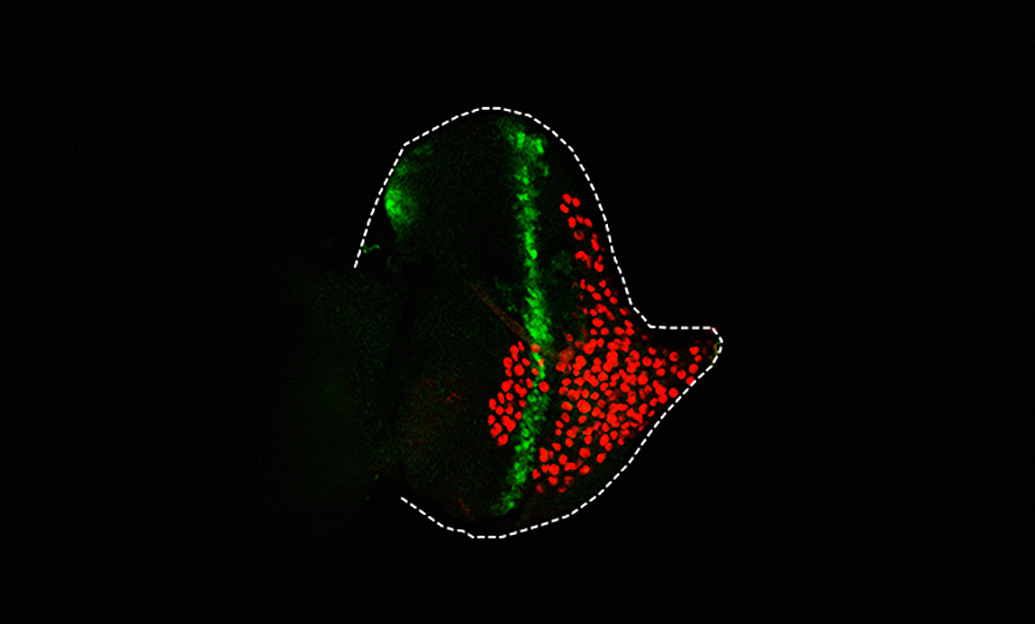Cell Growth and Differentiation
ABOUT
Our group studies the regulation of cellular properties by transcriptional and signaling networks during organogenesis. The complex coordination of these processes makes mandatory the use of in vitro and in vivo contexts for the characterization of key genes and genetic networks. Regarding the in vivo approaches, we use two genetically tractable model organisms: the fruit fly (Drosophila melanogaster) and zebrafish (Danio rerio).
RESEARCH
Line 1: Functional genomics approaches to study cell growth and differentiation in Drosophila
RESEARCH TEAM: Paulo Pereira, Silvana Lobo, Raquel Ramos, Adriana Serra
My main research aim is to understand at the molecular level how distinct cell types co-develop to form functional organs. For that approach, our group has a long-standing interest in studying cell growth and differentiation during tissue development in the fruit fly genetic model. My objectives are the study of: novel genetic and molecular mechanisms used by key signaling pathways and regulators, such as the TGFβ pathway and the oncogene Myc, mainly in the context of the complex bidirectional crosstalk between dynamic photoreceptor proliferation/differentiation and retinal glia migration and functions. iii) Furthermore, in collaboration with other groups, we will use Drosophila as an in vivo “functional genomics platform” to explore cellular and tissue dynamics. Drosophila is a useful model to study multiple aspects of cancer, and in collaboration with Dr. Carla Oliveira (Expression Regulation in Cancer group, i3S) we will also explore the fly model to study Hereditary Diffuse Gastric Cancer (HDGC), building on our previous work.
Line 2: Genetics and morphogenesis during development and cancer
RESEARCH TEAM: Renata Freitas, Catarina Oliveira
Hox genes encode transcription factors that are crucial for embryonic development, influencing tissue growth, patterning, and differentiation. Hox gene mutations are frequently associated with human malformations and altered levels of expression have been documented during oncogenic processes. The main focus of our research is to unravel the mechanisms activated by Hox transcription factors during embryonic development and cancer, and how they are regulated at the transcriptional level. We are currently characterizing mechanisms directly regulated by Hox proteins in zebrafish to better understand how their expression affects limb morphogenesis. In parallel, we are also characterizing mechanisms triggered by the dysregulation of Hox genes in breast cancer. More recently, we have also started to carry out drug trials for the development of novel therapies against cancer, namely to discover compounds that can reverse the effects of Hox gene dysregulation in oncological contexts.

Team
Selected Publications
Feedback control of organ size precision is mediated by BMP2-regulated apoptosis in the Drosophila eye. PLoS Biology22(1):, 2024. [Journal: Article] [CI: 4] [IF: 7.2]
DOI: 10.1371/journal.pbio.3002450 SCOPUS: 85183785216
Tavares L., Grácio P., Ramos R., Traquete R., Relvas J.B., Pereira P.S.
The Pebble/Rho1/Anillin pathway controls polyploidization and axonal wrapping activity in the glial cells of the Drosophila eye. Developmental Biology473:90-96, 2021. [Journal: Article] [CI: 1] [IF: 3,1]
DOI: 10.1016/j.ydbio.2021.02.002 SCOPUS: 85101016149
Castro J., Beviano V., Paço A., Leitão-Castro J., Cadete F., Francisco M., Freitas R.
Hoxd13/Bmp2-mediated mechanism involved in zebrafish finfold design. Scientific Reports11(1):, 2021. [Journal: Article] [CI: 3] [IF: 5]
DOI: 10.1038/s41598-021-86621-4 SCOPUS: 85103746071
de Bessa Garcia S.A., Araújo M., Pereira T., Mouta J., Freitas R.
HOX genes function in Breast Cancer development. Biochimica et Biophysica Acta - Reviews on Cancer1873(2):, 2020. [Journal: Review] [CI: 62] [IF: 10,7]
DOI: 10.1016/j.bbcan.2020.188358 SCOPUS: 85082425239
Pinho M., Macedo J.C., Logarinho E., Pereira P.S.
NoL12 repression induces nucleolar stress-driven cellular senescence and is associated with normative aging. Molecular and Cellular Biology39(12):, 2019. [Journal: Article] [CI: 13] [IF: 3,6]
DOI: 10.1128/MCB.00099-19 SCOPUS: 85066485467
García-Morales D., Navarro T., Iannini A., Pereira P.S., Míguez D.G., Casares F.
Dynamic Hh signalling can generate temporal information during tissue patterning. Development146(8):, 2019. [Journal: Article] [CI: 7] [IF: 5,6]
DOI: 10.1242/dev.176933 SCOPUS: 85065344120
Eusebio N., Tavares L., Pereira P.
CtBP represses Dpp-dependent Mad activation during Drosophila eye development. Developmental Biology442(1):188-198, 2018. [Journal: Article] [CI: 4] [IF: 2,9]
DOI: 10.1016/j.ydbio.2018.07.018 SCOPUS: 85050401082
Tavares L., Correia A., Santos M.A., Relvas J.B., Pereira P.S.
dMyc is required in retinal progenitors to prevent JNK-mediated retinal glial activation. PLoS Genetics13(3):, 2017. [Journal: Article] [CI: 8] [IF: 5,5]
DOI: 10.1371/journal.pgen.1006647 SCOPUS: 85016620416
Martins T., Eusebio N., Correia A., Marinho J., Casares F., Pereira P.S.
TGFβ/Activin signalling is required for ribosome biogenesis and cell growth in Drosophila salivary glands. Open Biology7(1):, 2017. [Journal: Article] [CI: 12] [IF: 3,3]
DOI: 10.1098/rsob.160258 SCOPUS: 85012931855
Neto M., Naval-Sánchez M., Potier D., Pereira P.S., Geerts D., Aerts S., Casares F.
Nuclear receptors connect progenitor transcription factors to cell cycle control. Scientific Reports7(1):, 2017. [Journal: Article] [CI: 12] [IF: 4,1]
DOI: 10.1038/s41598-017-04936-7 SCOPUS: 85021927654
Tavares L., Pereira E., Correia A., Santos M.A., Amaral N., Martins T., Relvas J.B., Pereira P.S.
Drosophila PS2 and PS3 integrins play distinct roles in retinal photoreceptors-glia interactions. GLIA63(7):1155-1165, 2015. [Journal: Article] [CI: 11] [IF: 6]
DOI: 10.1002/glia.22806 SCOPUS: 84928206519
Marinho J., Martins T., Neto M., Casares F., Pereira P.S.
The nucleolar protein Viriato/Nol12 is required for the growth and differentiation progression activities of the Dpp pathway during Drosophila eye development. Developmental Biology377(1):154-165, 2013. [Journal: Article] [CI: 15] [IF: 3,6]
DOI: 10.1016/j.ydbio.2013.02.003 SCOPUS: 84876321493
Freitas R., Gómez-Marín C., Wilson J.M., Casares F., Gómez-Skarmeta J.L.
Hoxd13 Contribution to the Evolution of Vertebrate Appendages. Developmental Cell23(6):1219-1229, 2012. [Journal: Article] [CI: 79] [IF: 12,9]
DOI: 10.1016/j.devcel.2012.10.015 SCOPUS: 84870845601
Caldeira J., Simões-Correia J., Paredes J., Pinto M.T., Sousa S., Corso G., Marrelli D., Roviello F., Pereira P.S., Weil D., Oliveira C., Casares F., Seruca R.
CPEB1, a novel gene silenced in gastric cancer: A Drosophila approach. Gut61(8):1115-1123, 2012. [Journal: Article] [CI: 43] [IF: 10,7]
DOI: 10.1136/gutjnl-2011-300427 SCOPUS: 84863719147
Martin D., Pantoja C., Fernández-Miñán A., Valdes-Quezada C., Moltó E., Matesanz F., Bogdanović O., De La Calle-Mustienes E., Domínguez O., Taher L., Furlan-Magaril M., Alcina A., Cañóon S., Fedetz M., Blasco M.A., Pereira P.S., Ovcharenko I., Recillas-Targa F., Montoliu L., Manzanares M., Guiǵo R., Serrano M., Casares F., Gómez-Skarmeta J.L.
Genome-wide CTCF distribution in vertebrates defines equivalent sites that aid the identification of disease-associated genes. Nature Structural and Molecular Biology18(6):708-714, 2011. [Journal: Article] [CI: 75] [IF: 12,7]
DOI: 10.1038/nsmb.2059 SCOPUS: 79958834622
Marinho J., Casares F., Pereira P.S.
The Drosophila Nol12 homologue viriato is a dMyc target that regulates nucleolar architecture and is required for dMyc-stimulated cell growth. Development138(2):349-357, 2011. [Journal: Article] [CI: 21] [IF: 6,6]
DOI: 10.1242/dev.054411 SCOPUS: 78751553525
Freitas R., Zhang G.J., Cohn M.J.
Evidence that mechanisms of fin development evolved in the midline of early vertebrates. Nature442(7106):1033-1037, 2006. [Journal: Article] [CI: 176] [IF: 26,7]
DOI: 10.1038/nature04984 SCOPUS: 33748305741
Pereira P.S., Teixeira A., Pinho S., Ferreira P., Fernandes J., Oliveira C., Seruca R., Suriano G., Casares F.
E-cadherin missense mutations, associated with hereditary diffuse gastric cancer (HDGC) syndrome, display distinct invasive behaviors and genetic interactions with the Wnt and Notch pathways in Drosophila epithelia. Human Molecular Genetics15(10):1704-1712, 2006. [Journal: Article] [CI: 31] [IF: 8,1]
DOI: 10.1093/hmg/ddl093 SCOPUS: 33745184835
Freitas R., Cohn M.J.
Genomic regulation of Hox collinearity. Developmental Cell10(1):8-9, 2006. [Journal: Short Survey] [CI: 3] [IF: 13,5]
DOI: 10.1016/j.devcel.2005.12.008 SCOPUS: 29744445744

